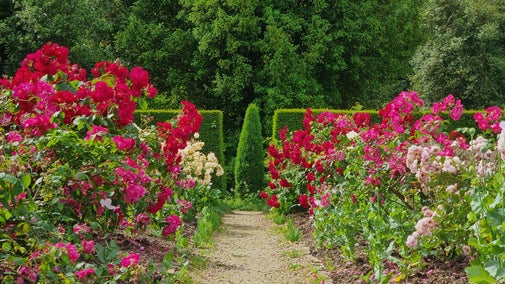
Donate
Everyone needs nature, now more than ever. Donate today and you could help people and nature to thrive at the places we care for.

Home to a 300-year-old house containing nearly 5,000 collection items, as well as an eight-acre garden and the wider estate, a lot of work goes in to caring for Gunby. From cleaning ceramics to replanting apple trees, find out more about our work at Gunby.
With thousands of items to look after in the many rooms of Gunby’s homely country house, the house team have their work cut out.
In order to conserve the collection, the team need to manage the ‘agents of deterioration’ which can cause irreparable damage to the house and its contents.
Sunlight causes irreversible damage to organic items in the collection like textiles and wood. The team control the amount of light that falls on to the collection by using blinds and installing UV filters on the windows.
Traps are positioned around the house to check for the presence of pests. The traps capture creepy crawlies such as moths, silverfish and furniture beetles which could damage the collection. The team can use these traps to monitor what unseen pests are present within the house and take appropriate action if required.
The housekeeping team regularly monitors the relative humidity (the amount of moisture in the air) and tries to maintain it within a set band. Both high and low relative humidity causes damage to objects within the collection and can encourage pest infestations and mould growth.

Once a year the rooms in the house are turned upside down to give the housekeeping team a chance to clean every corner of each room and objects within. This means that many collection pieces have to move temporarily into adjacent rooms. The rooms are then cleaned from top to bottom before the objects are carefully returned to their places.
– Peter, Conservation volunteer
Ceramics, such as the Delftware items in the collection, are given a careful clean with cotton wool. Some warm water with a little gentle detergent is used to carefully lift any surface dirt. As some of the Delftware is damaged, the team take great care to make sure moisture doesn't penetrate the broken areas and previous repairs.
The extensive Gunby glass collection also comes out of its cupboards once a year for a gentle brush and, when necessary, a clean.
Some items in the Gunby collection are stored on site and most of these pieces need specialist restoration or repair before they can be displayed. The items are checked regularly to monitor their condition.
As well as caring for the house and collection at Gunby there is work taking place outdoors in the garden and estate.
There are a number of owl boxes on the estate and specialist volunteers regularly check these to see which birds are calling the estate home. Any un-ringed birds are ringed so that they can be tracked and checked up, and birds are weighed and recorded. Any chicks born are also weighed, checked for injuries and ringed.
The Gunby estate is home to a number of birds of prey, including tawny owls, barn owls and kestrels.

As well as caring for wildlife on the estate the team are also working to restore areas of the garden, such as Field Marshal’s orchard.
A programme has been under way for more than ten years to replace trees as the older trees have died out. The east garden was planted as an orchard starting in the early 1990s, initially to accept some grafts taken from the Field Marshal’s orchard along with suitable additional trees.
2006 saw a new line of oblique cordons planted: Egremont Russet, Worcester Pearmain and the local Ellisons Orange. There is evidence that such cordons existed in the gardens at an earlier time.
In January 2014 a short line of step-over trees were planted, forming a vegetable border divide and demonstrating another style of fruit tree training. The varieties are Katy from 1947 and Discovery with the unusual bright red Bloody Ploughman to complete the line, this being grafted by the team from locally sourced scions.
Recent grafting attempts to replicate some of the garden’s varieties for replanting is under way, with successful grafts planted in the fruit cage area to grow on. An addition to this is an attempt to rescue and conserve a Lincolnshire apple known as Penny Loaf.
With your ongoing support, we're able to continue our vital conservation work. Thank you for helping to protect these special places.

Everyone needs nature, now more than ever. Donate today and you could help people and nature to thrive at the places we care for.
Plan your visit to Gunby Estate and Gardens in Lincolnshire. There is no need to pre-book your visit at the moment.

From the remnants of a medieval village to a charming red-brick house with a Victorian flourish, Gunby was home to the Massingberd family for over 250 years—though the estate’s story stretches back even further.

Explore Gunby Hall, which was home to the Massingberd family for over 250 years. The house features intimate living spaces filled with notable objects, artistic works, and homely décor.

Find out more about volunteering opportunities at Gunby and how you can join the team to play your part in looking after this homely country house and estate.

Find out more about the 1,500 acres of the Gunby Estate. Take a walk to discover an ice house pond, remains of a lost village and find evidence of a demolished medieval moated manor.

Discover eight acres of different garden ‘rooms’ with many different colours and textures to enjoy. Throughout each season there is something different to see.

Read about our strategy, which focuses on restoring nature, ending unequal access and inspiring more people.

We believe that nature, beauty and history are for everyone. That’s why we’re supporting wildlife, protecting historic sites and more. Find out about our work.
